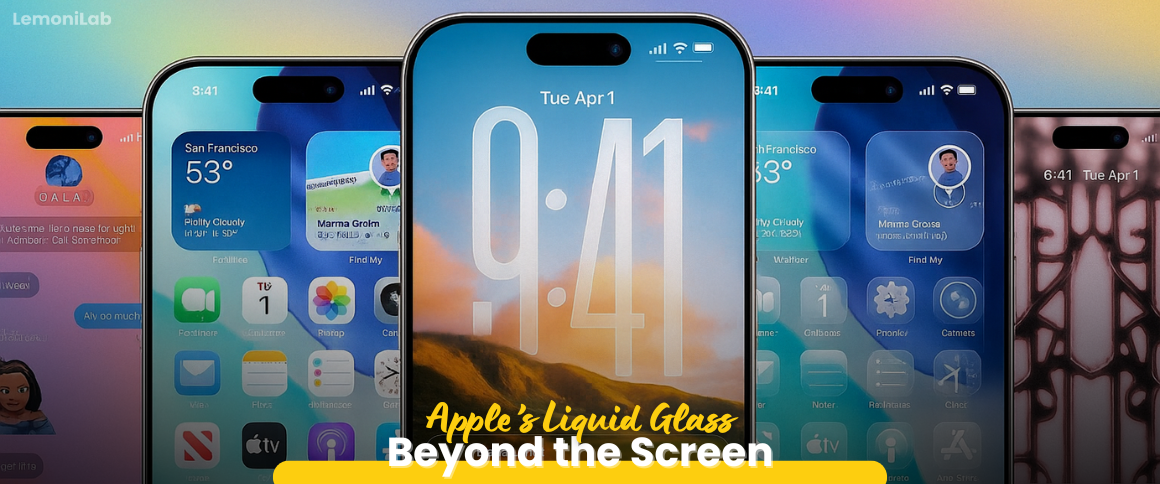Apple’s Liquid Glass Isn’t Just an Interface, It’s a Signal of What’s Coming

Apple has always been known for taking calculated steps in its UI evolution. But with the introduction of Liquid Glass at WWDC 2025, it’s not just changing the look and feel of iOS 26, iPadOS, and macOS, it’s redefining what we expect from digital interfaces.
What is Liquid Glass, Technically Speaking?
At its core, Liquid Glass is a dynamic UI rendering system that uses advanced layering, translucency algorithms, and real-time light simulation to create an almost tactile visual experience. It's not just about aesthetics. It’s a performance-optimized, GPU-accelerated engine built on Apple’s Metal architecture, designed to handle real-time animations with fluid transitions, even under pressure from multitasking.
This new UI layer goes beyond “glassmorphism.” Instead of simulating depth, Liquid Glass reacts to system context. It warps, breathes, and pulses depending on your actions, giving every touch and gesture a sense of presence.
“It feels like touching light,” said one reviewer after using the new Control Center in iOS 26, which now slides in with adaptive opacity based on ambient brightness and task priority.
Why It Matters: A Paradigm Shift in UX Philosophy
Liquid Glass isn’t about beautifying the OS, it’s a signal that interfaces are becoming emotional experiences. Apple has essentially blurred the line between UI responsiveness and human intuition.
From a technical standpoint:
-
It uses machine-learned behavior mapping to predict user interaction flow.
-
Supports modular UI reconstruction, meaning developers can now create widgets and panels that adapt their layout based on user attention and context.
-
Offers haptic-synced motion effects, allowing visual feedback to match the feel of the device, transforming the UI into a sensory feedback loop.
According to TechCrunch, the beta 2 release includes improved GPU efficiency that reduces battery strain by dynamically scaling animations based on thermal load—a technical feat that marries UX fluidity with device health.
Practical Impacts Across Apple’s Ecosystem
-
On iOS 26, the Control Center becomes not just a utility panel but a living surface, responding to swipes with depth-sensitive motion and new customizable stacks.
-
On macOS, window layering and focus states now visually shift depending on task flow, leveraging Liquid Glass to reduce distraction and improve cognition.
-
For developers, this means rethinking layout logic and re-engineering assets for motion-based rendering using SwiftUI’s updated Material protocols.
According to India Times, Liquid Glass “creates interfaces that mimic light refraction in real time,” giving a sense of realism that may soon set a new standard in digital aesthetics.
The Honest Truth, And a Human Perspective
Liquid Glass is beautiful. It's smart. It’s responsive. But let’s not forget: it’s also intentionally hypnotic. Designed to blur edges between human and machine, it subtly pulls us deeper into the device.
Here’s the bold truth: this is not just about design, it’s about control. Control of attention, flow, and user time. Every shimmer, every soft scroll, every pulse of light is engineered to feel seamless, comforting, yet persuasive.
And yet, there’s beauty in that. Like waves adapting to a shoreline, interfaces like Liquid Glass hint at a future where technology feels alive, but also more invisible.
The Future of UI is Not Flat, It’s Fluid
Liquid Glass isn’t just an interface innovation; it’s an invitation to reconsider our relationship with the digital world. Apple isn’t just crafting experiences anymore, it’s sculpting emotional space inside a screen.
As developers and users in the GCC and beyond, the question isn’t whether we adopt it, but how intentionally we use it. Will we design systems that mimic nature to soothe and serve? Or ones that merely seduce attention?
Because in a world increasingly ruled by screens, the most radical thing might be to build interfaces that remind us of the natural world outside the device, not just reflect it.
Ready to build immersive, intuitive, and ethical digital experiences?
Contact LemoniLab today to bring human-first design to your next app or product. Let’s create something that feels, not just functions.
